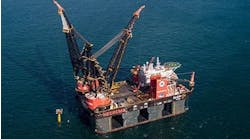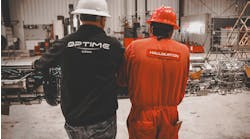Offshore Exclusive: Collaboration delivers P&A lightweight well intervention system
Gordon Sutherland, Enovate Systems Ltd.
With decommissioning possibly higher on the industry’s agenda than before, finding new ways to innovate to ensure the plug and abandonment (P&A) process is performed as safely and smoothly as possible is becoming ever more important.
Plugging a well means putting barriers down the well to prevent anything from beneath leaking out. For some years now, the industry has been calling for less complex ways to carry out this necessary task.
Wells account for one half of the decommissioning bill. In recent years, there has been an enhanced focus on improving existing techniques and methods in a bid to cut the time and costs associated with the P&A process. One way which has proven to be effective in achieving both is through optimizing well access systems.
Well access systems provide a safe route to subsea wells throughout the life of field, from the installation and commissioning of a new well, to decommissioning through P&A.
There are two forms of well intervention, light and heavy. Light intervention is generally the use of wireline and slickline to change downhole equipment, remove any blockages, and gather well data. These operations can be performed using a riserless well access system.
Heavy interventions are operations which require full access to the wellbore and may require deployment of a riser to enable running of coil tubing or the retrieval of downhole equipment.
Historically, well access systems were all riser based until the first riserless light well intervention (RLWI) campaign was carried out in 1987. Since then, lighter, more compact systems have emerged, enhancing functionality and flexibility.
Enovate Systems Ltd. recently launched a P&A lightweight well intervention system, which was developed in collaboration with a major North Sea operator and the Oil and Gas Technology Centre.
Part of its design intent was to deliver a lightweight, modular system enabling access to wells where fatigue issues are present. In the North Sea, where the average asset age is around 25 years, wellhead fatigue is common, therefore, the use of traditional heavy intervention systems may not be suitable.
The new system has the benefit of being lighter in weight than conventional riser based and even some riserless systems, with the advantage of having a riser to allow for coil tubing operations if required. The modular design can be adapted with relative ease to run riserless with a lubricator section and the company’s field proven open water latch system. This includes pressure control heads for deployment of tool strings on e-line and slickline. Having the option to run riserless or riser based allows flexibility for deployment from either a semisubmersible or monohulled vessel for light and heavy intervention methods.
The system features many of the company’s field proven technologies, including En-Power ball valves for well control. Using ball valves for this application helps reduce the overall weight by about two-thirds when compared to conventional systems.
The system also includes open water latch as well as its En-Balance bore selector technology. The bore selector removes the need to deploy the system on a dual bore riser to gain access to the production or annulus bores of a dual bore vertical xmas tree. Instead, running a monobore riser, the bore selector can be hydraulically functioned from surface allowing mechanical access to the production or annulus bores to provide mechanical access. Fluid access beneath the bore selector is achieved via a circulation loop containing a series of gate valves that provide the required well barriers.
There are benefits also when deploying in riserless mode, with the use of the bore selector eliminating the need to roundtrip the system to gain access to annulus bore; saving considerable time on retrieving, re-configuration, proof testing, and re-deployment of the system.
For horizonal xmas trees, where the use of a bore selector is not required, it can simply be removed from the system and replaced with an optional additional shear and seal device with a connector to allow interfacing with any original equipment manufacturer’s horizontal tree.
The new system delivers time savings of up to three days per well for P&A, and up to seven days for well intervention of shut-in wells that require multiple runs into the annulus. Compared to traditional rig intervention with a standard riser, time and cost savings of up to 60% can be achieved. This approach also reduces the number of operational activities, minimizing the risks associated with man riding tasks.
Well mechanics are a key component to a successful and efficient P&A. Addressing technical challenges in a subsea environment comes with the territory. With a modular, configurable system; advances in efficiencies, improvements, and expansion of capabilities can be achieved, delivering significant time saving and cost benefits.
Continuing to address the challenges that come with P&A programs will be crucial in shaping the end-of-life market in the North Sea over the coming years. Collaborative initiatives can provide an essential contribution to technology development. In order to support operators and overcome the barriers, we must work in partnership with the enablers and end users.
The P&A learning curve has been steep. The challenges come in many forms: technical, regulatory, and environmental. Ensuring all are considered and managed can be a difficult and lengthy processes. The right balance between reducing cost and time to create fail proof, long-term solutions must be sought.
As an industry, we have not quite cracked it yet, but are closer than ever before. There is still a need for further, more advanced technology developments, but it will require the industry to work collaboratively with the supply chain to ensure the required systems are developed.
The current market conditions may prove to be just the impetus required to facilitate the appropriate level of action needed to ensure wells are safely and permanently plugged and abandoned. Outside of the UK, the opportunities are big, with rapidly aging assets in the subsea sector in Asia, Africa, North and South America presenting decommissioning opportunities over the next decade.



